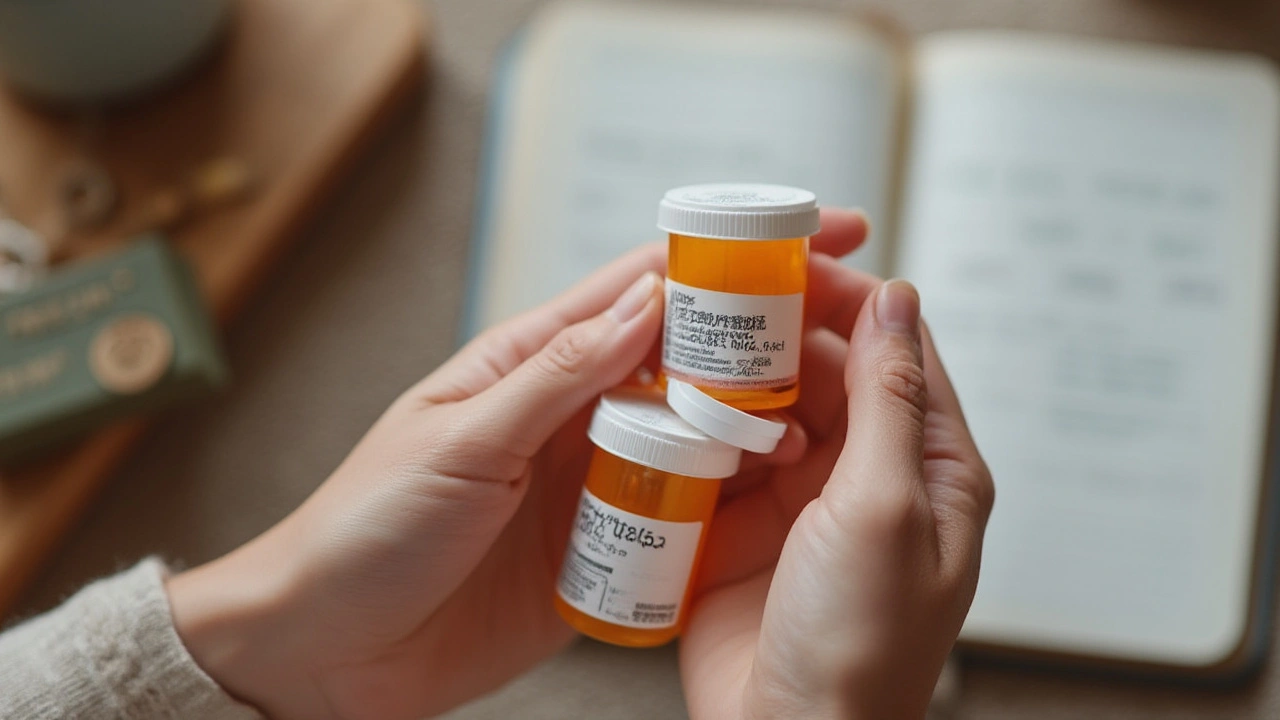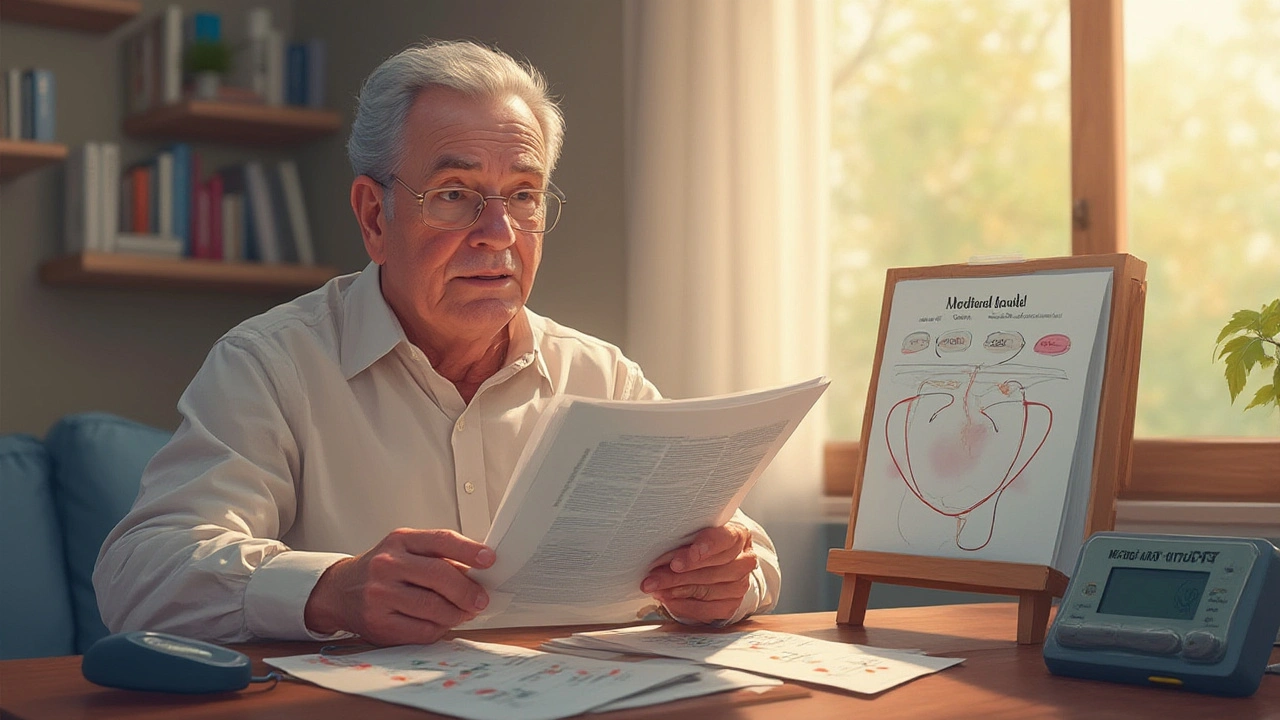Stopping propranolol isn’t as simple as just not taking your next pill. Get this wrong, and your heart might pound, your blood pressure can spike, and your anxiety may come roaring back. The catch? The real danger often comes from doing nothing and letting withdrawal symptoms race out of control. Even if you aren’t scared by statistics, here’s one: in a survey of people who stopped beta-blockers suddenly, nearly half experienced significant rebound symptoms. The good news? With a cardiologist-approved plan, you can dodge the worst of these problems.
Understanding Why Tapering Is Key
Propranolol works by slowing your heart rate and reducing your body's response to adrenaline. That gentle hand gives your heart a break. But once you pull propranolol away all at once, your body can overcorrect—imagine someone slamming on the gas pedal after easing off the brakes. This is what doctors call "rebound tachycardia"—a sudden, sometimes scary, fast heartbeat that risks your safety. Studies show that the risk of this happening depends on how high your dose is, how long you’ve been on the drug, and your overall heart health. People on propranolol for months or years are especially at risk if they stop without a plan. The body adjusts to having less adrenaline floating around, so when the blocker disappears, that pent-up adrenaline has nothing to stop it.
Typical withdrawal effects go beyond a rapid pulse. You may notice your blood pressure climbing, anxiety spiking, even shakes or headaches. What many people don’t realize: The lowest, safest bet is to let your body catch up slowly. That’s why–unless your doctor orders otherwise–tapering is the gold standard. In fact, guidance from the American Heart Association emphasizes tapering for all beta-blocker users whenever possible, especially those with a previous history of heart problems.
Your doctor will look at your dose, your health, and decide your off-ramp. The most basic taper involves cutting your daily propranolol dose by 25% each week. A slower approach, especially for higher doses, is a 10% reduction every seven days. For example: A 40 mg twice-daily user might drop to 30 mg twice daily for a week, then 20 mg, then 10 mg, then stop. That’s just one example; yours might be faster or slower, depending on your situation.
You’ll notice most schedules recommend not just dose reductions, but also monitoring your blood pressure and pulse, often daily if you’re high risk. Your provider may even ask you to record symptoms like palpitations or chest pain in a journal. Pro tip: digital blood pressure cuffs and smartphone heart rate apps can make this tracking much easier. The secret sauce is letting your body recalibrate at each step. If you feel chest pain, breathlessness, confusion, or a fast, pounding heart, it’s a signal to call your doctor, not to tough it out alone.
Check out the table below for a simplified illustration of a sample taper schedule:
| Week | Morning Dose | Evening Dose | Notes |
|---|---|---|---|
| 1 | 30 mg | 30 mg | Start reduction |
| 2 | 20 mg | 20 mg | Continue monitoring |
| 3 | 10 mg | 10 mg | Almost there |
| 4 | 0 | 0 | Stopped |
Notice how the dose slashes each week? Listen to your body as you go. Some people need to step down even slower. Never be afraid to ask your provider to adjust the schedule if you start feeling unwell during the taper.

Preventing Rebound Tachycardia and Blood Pressure Spikes
That pounding heartbeat after dropping propranolol? It’s real—and it can land you in the ER if left unchecked. Around 40% of propranolol users who go cold-turkey see their heart rate soar above 120 bpm, according to peer-reviewed research. This isn’t just uncomfortable—it can trigger chest pain or even an arrhythmia, especially if you already have heart risks. But what’s really going on? Your nervous system, finally freed from its propranolol leash, starts firing off more adrenaline. That cranks your heart up and can shoot your blood pressure through the roof.
This is why doctors always rant about slow tapering. When you step down your dose gradually, you help sneak your sympathetic nervous system back online without a surge. Medical recommendations favor at least 2-4 weeks of stepwise reductions for anyone who’s been on propranolol longer than a month. And if your heart disease risk is higher (think: previous heart attack, arrhythmia or long-standing high blood pressure), your doc may want you to stretch the taper even longer or add extra visits just to be safe.
During this time, keeping tabs on your body is essential. Here’s what cardiologists suggest you monitor daily—or even twice a day if possible:
- Resting heart rate (use a wrist monitor or a phone app)
- Blood pressure (automatic cuffs are best, keep a record)
- Symptoms like chest pain, shortness of breath, pounding in your chest, severe anxiety, lightheadedness
If your heart rate or blood pressure shoots up—say, 20% higher than your normal average—don’t just worry: contact your healthcare provider. In some cases, they may pause your taper, step your dose back up a notch, or even switch you over to another type of blood pressure medication temporarily. Don’t ignore the signals your body sends. Think of your symptoms as “progress reports” that help fine-tune your plan.
Your provider may also want to schedule a follow-up ECG or lab tests during your taper, especially if you’ve got a history of heart rhythm problems. Don’t cancel these appointments—they’re sometimes the only way to catch dangerous changes before they become an emergency.
Ever wonder if there’s something you can do besides the medication to help your heart stay steady? Turns out, lifestyle tweaks matter here, too. Keeping caffeine low, limiting alcohol, and practicing stress-reducing routines like slow breathing or yoga can lessen your risk of rebound effects. Magnesium-rich foods also support healthy heart rhythm—load up on spinach, avocados, and almonds. If you smoke, now’s the time to double down on quitting, since nicotine also hypes up your nervous system.
If you’re worried your body just doesn’t vibe with propranolol or if you suspect the side effects outweigh the benefits, chat with your cardiologist early. There’s a whole world of blood pressure and heart health meds out there. For example, some folks successfully move to calcium channel blockers, ACE inhibitors, or even newer beta-blockers with longer half-lives, which can make future tapers easier. You can check out more details about finding a replacement for Inderal (that’s just another name for propranolol) if you want to get ahead of the conversation with your doctor.

Tips and Tools for Safe Propranolol Withdrawal
The real secret to getting off propranolol safely? Planning, patience, and paying attention. Start by getting your own monitoring gear: a quality blood pressure cuff and a reliable heart rate check tool (smartwatches or fitness bands are perfect for this, but even basic apps work). Make a daily log—jot down your pulse, your blood pressure, and how you’re feeling. Any flutter, chest tightness, headache, or spike in nervousness gets recorded. Show these records to your healthcare provider at your check-ins; having clear data can help you and your doctor adjust your taper if things get bumpy.
Stay hydrated, eat consistently, and skip meal-skipping—low blood sugar makes withdrawal tougher. Don’t power through if symptoms are bad. If you can, ask a family member or close friend to keep tabs on you, especially during the days when your dose drops. Sometimes folks don’t notice their own symptoms sneaking up.
Some practical tricks: Take your medications at the same time each day to keep your rhythm steady as you taper. If you take other meds for blood pressure, don’t adjust these without your doc’s green light—changing two things at once clouds the picture if something goes wrong. Consider breaking larger propranolol tablets in half or quarters (with your prescriber’s OK); smaller reductions are safer for sensitive systems.
If you do get hit by rebound symptoms, resist the urge to just "tough it out." Sometimes, the right move is to hold your taper at that dose a week longer. Rarely, your doctor may add a tiny dose of another beta-blocker or calming medicine just for a week or two, creating a bridge while your body adjusts. Don’t jump to anxiety meds or sleeping pills unless your prescriber agrees. The aim is a gradual shift, not a trading of side effects.
Worried about recurrence of the condition for which you started propranolol—like migraines or stage fright or PTSD? Keep using your non-drug strategies even as you step off the medication. Mindfulness, relaxation training, physical activity, and sticking to a solid sleep schedule all work wonders for bouncing back and keeping triggers in check. For some, it’s worth connecting with a support group, especially if anxiety is a big part of why you needed propranolol in the first place. Several online forums and local patient groups can make you feel less alone in this process.
Finally, remember: there’s no gold medal for suffering through withdrawal symptoms, but there is peace of mind in knowing your heart’s in good hands. Safe weaning is less about willpower and more about smart, steady steps. Your doctor’s goal—and yours—should be a smooth transition, not a heroic leap into discomfort. If your plan isn’t working, speak up. There’s almost always a tweak, a slower schedule, or another medication that can keep you on track. You never have to do this on your own.


Sondra Johnson
July 17, 2025 AT 02:45I literally cried when I finally tapered off propranolol after 5 years. The first week felt like my heart was trying to escape my chest-like a hummingbird trapped in a wine bottle. But I stuck to the 10% weekly drop, tracked my BP with my Fitbit, and drank way too much coconut water. My anxiety didn’t vanish, but it stopped screaming. Now I do yoga, eat avocado toast like it’s my job, and I’m basically a new person. Don’t let fear hold you back-just go slow, baby.
Chelsey Gonzales
July 17, 2025 AT 11:49omg yes!! i did the 25% a week thing and thought i was gonna die on week 2. my heart was doing the cha-cha and my hands were shaking like i was holding a cup of espresso. but i kept a journal and my doc told me to chill. turned out i was just nervous. now im off and feel way more alive. dont be scared, just be smart.
MaKayla Ryan
July 18, 2025 AT 11:02This is why America’s healthcare system is broken. You need a cardiologist to stop taking a pill? My grandma in ’78 just quit cold turkey and lived to 94. No apps, no journals, no fancy charts. You people are overmedicalizing everything. Stop being weak. Just quit.
Kelly Yanke Deltener
July 19, 2025 AT 12:37I’ve been on propranolol since my divorce. I cried when I read this. I’m scared. What if I go back to being that anxious mess? What if I can’t handle my own emotions without this chemical leash? I don’t want to feel anything again. But… I also don’t want to be a zombie. Can someone tell me it’s okay to want both?
Sarah Khan
July 20, 2025 AT 06:46The neurophysiology here is fascinating. Propranolol doesn’t just block beta-receptors-it modulates the entire autonomic feedback loop between the amygdala and the sinoatrial node. When you abruptly remove it, the sympathetic nervous system doesn’t just rebound-it overshoots, because the baroreceptor sensitivity has been downregulated over weeks or months of pharmacological suppression. This isn’t withdrawal in the addictive sense; it’s physiological recalibration. The 10% weekly taper isn’t arbitrary-it’s the approximate time constant for sympathetic re-sensitization. That’s why the AHA recommends it. You’re not fighting your body-you’re helping it relearn how to breathe again.
Kelly Library Nook
July 21, 2025 AT 07:57While the article presents a well-structured clinical framework, it lacks empirical citations for the 40% rebound tachycardia statistic. Furthermore, the recommendation to utilize consumer-grade wearable devices for hemodynamic monitoring is methodologically unsound due to known inaccuracies in photoplethysmography-derived heart rate under motion artifact conditions. I recommend cross-verifying all self-reported metrics with clinic-grade oscillometric measurements prior to clinical decision-making.
Crystal Markowski
July 22, 2025 AT 07:49You’ve got this. I’ve walked this path with three clients-each one terrified, each one surviving. The key isn’t perfection. It’s presence. If you feel shaky, breathe. If your heart races, sit down. If you’re scared, call someone. You’re not failing-you’re healing. And you don’t have to do it alone. I’m here if you need to talk. No judgment. Just support.
Charity Peters
July 22, 2025 AT 09:35I just stopped it one day. Felt weird for a bit. Then I was fine. Maybe it’s different for everyone.
Faye Woesthuis
July 23, 2025 AT 18:36People like you are why hospitals are full. You’re addicted to the idea of needing help. Just quit. Stop making excuses. This isn’t therapy. It’s medicine.
raja gopal
July 25, 2025 AT 06:18I was on this medicine for anxiety after my dad passed. Tapered slowly over 3 months. It was hard, but I prayed every morning and walked in the park. Now I’m off, and I feel more like myself than ever. You’re not weak for needing help-you’re brave for trying to let go. Keep going. You’re not alone.